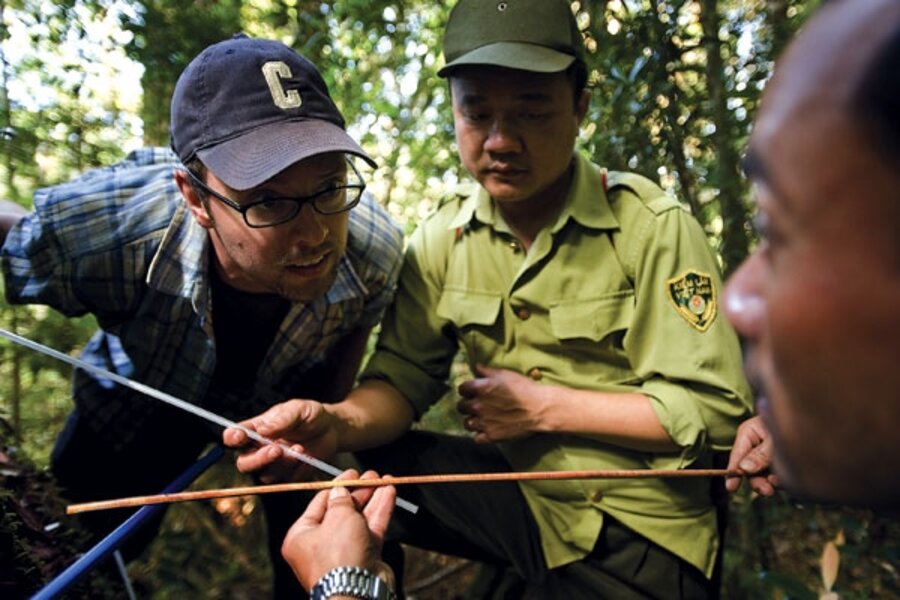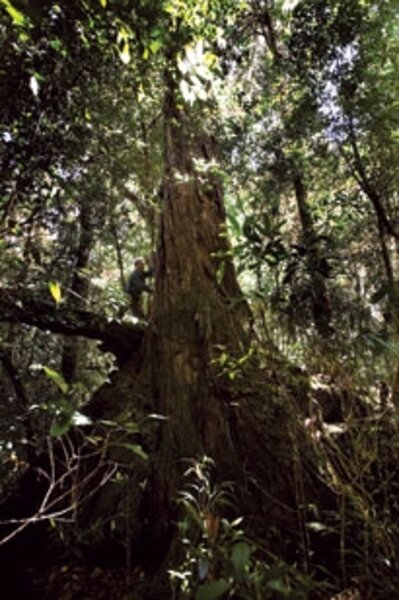The secret life of ancient trees
Loading...
| Da Lat, Vietnam
A thousand years ago, the steep slopes of Vietnam’s southern highlands were cloaked by forests of towering pines and other trees. Tribesmen roamed the forests, hunting wild boar and deer under a lush canopy of laurels and oaks.
In their quest for sustenance, they moved slowly through an understory of tangled bamboo and palms. Thick layers of moss and decaying leaves muffled their footsteps as they stalked their prey.
On the forest floor, the seed of a Fokienia hodginsii tree sprouted in the moist detritus. As it grew, a chronicle of each year of its life was locked into narrow bands inside its trunk – light for the beginning of a growing season and dark marking winter.
Now, a thousand years later, Vietnamese forest specialist Le Canh Nam and American tree ring scientist Brendan Buckley are hunting in the forest. But their quarry isn’t wild boar or deer. It’s the tree that grew from the Fokienia hodginsii seed and has survived for a millennium, growing into an ancient giant.
Like the hunters of the past, Mr. Nam walks deliberately through prickly stands of rattan palms and over downed trees in what is now Bidoup-Nui Ba National Park near Da Lat, Vietnam.
Nam’s quest began two years ago when he was asked by Dr. Buckley to find ancient Fokienia hodginsii trees from which he and a team of scientists could extract tree rings to help with climate studies.
Buckley and his colleagues have spent the past five years working with collaborators in more than a dozen countries to reconstruct information about historical monsoons from tree rings. Such data is useful for climate modelers, who want to find out how global warming might affect monsoon rainfall.
The models that predict rising temperatures are “very iffy” about precipitation patterns, says Edward Cook, director of Columbia University’s Lamont-Doherty Earth Observatory (LDEO) Tree- Ring Laboratory. That puts a premium on figuring out how much it rains from year to year in Asia’s densely populated river deltas. Tree rings help scientists understand past climate variations.
Nam spent a week in the forest searching for big trees. Now he is guiding the group back to a promising site.
“A tree that is beautiful to me is probably ugly to most people, says Buckley. “Mine are twisted and have been through hell on a weathered ridge or dry slope. Those are the trees I’m interested in.”
Buckley is considered the foremost tree-ring scientist (dendrochronologist) working in Southeast Asia and is a research scientist at LDEO’s Tree-Ring Laboratory. Nam consults his map, a global positioning system, and a compass, and relies on an intuitive sense of direction developed through years in the forest.
Close on Nam’s heels, Buckley twists his lanky body to avoid low-hanging limbs. Tucked safely inside his pack are two hollow corers used to extract narrow dowels of wood showing a tree’s growth rings. The air is heavy with humidity, and the climb is unrelenting.
Then Nam breaks through a clump of brush and stops, looks to his left, and says simply, “Fokienia.”
It is a massive evergreen tree. Lichens hang from the 6-foot-wide trunk and thick vines climb 120 feet to limbs hosting orchids, ferns, and mosses. It is exactly the kind of ancient tree that the researchers had hoped to find and whose climate history can now begin to be unlocked.
“A tree like this could be as old as the oldest ones we’ve gotten,” says Buckley. “The idea is so simple ... there is this organism sitting here and kind of recording what is going on in its environment and reliably so. When you find that right site that has whatever characteristic is necessary to give it an imprint of the overall climate and it just locks in, that’s a pretty special thing.”
Teak was once the most studied tree in the tropics, but it’s been backdated reliably only 400 years. Then, in the late 1990s, Japanese researchers discovered that Fokienia hodginsii had all the characteristics they were looking for in a tropical species. The tree had identifiable rings that were produced annually, the ring samples could be cross-dated between trees, and the ring patterns over time recorded the climate in which it grew.
LDEO research fellow Kevin Anchukaitis rests a hollow coring device against the trunk of a tree the team has labeled Tree No. 12 and turns it slowly to sink the bit. Within seconds, the corer begins its journey through time.
The forest silence is broken by a rhythmic “uRR, uRR, uRR,” as the 32-inch corer drives into the wood. Soon, the drill can go no farther. A quick spin in the opposite direction breaks off the end of the one-fifth of an inch piece of wood inside the hollow corer, and it is ready to extract.
Dr. Anchukaitis slowly pulls the core out, and his eyes widen as he quickly studies it.
“Oh, wow!” exclaims Buckley. “That’s incredible. [The growth ring pattern] just doesn’t stop. It’s slow growing all the way back.”
Tree No. 12’s growth rings are compacted tightly and nearly imperceptible, about 1/40th of an inch or narrower. The only way to reliably determine the tree’s age is to mount the sample, finely sand it, and painstakingly count the rings under a microscope back in the lab.
But Buckley knows that the tree is very old. “If I had to put my bets, I would say this is close to a thousand years old,” he says.
Buckley’s guess is confirmed months later when the cores from Tree No. 12 are analyzed at the LDEO lab in New York. The tree is dated back to 1029.
In Asia, the monsoon has long dictated the rhythms of life. More than 40 percent of the world’s population relies on water from the seasonal rainfall to grow food and for drinking. If there are disruptions to the monsoon, there are serious potential economic and social consequences.
In Bidoup-Nui Ba National Park, researchers have been able to get reliable climate data for the past 722 years using Fokienia tree ring data. Coupled with research that Buckley conducted in Thailand, he and his colleagues have established tree ring chronologies indicating severe periods of drought across mainland Southeast Asia in the early 1400s.
During this period, the ancient city of Angkor in present-day Cambodia went into rapid decline. While some historians have blamed this on invasions by the rival kingdoms of Siam and Champa, another possibility is that Angkor’s canals and reservoirs ran dry. That would have ended an ambitious expansion that had exhausted the available farmland. A second prolonged drought in the 18th century, which was noted by foreign visitors to Siam, coincided with political upheaval, including the sacking of the Siamese capital by Burmese invaders.
The causes of drought in Southeast Asia are complicated and still far from being understood. El Niño (the periodic warming of the eastern Pacific Ocean) causes a weaker southwest monsoon and a longer dry season in Asia. La Niña, which occurs when sea temperatures cool in the Pacific, triggers a heavier Asian monsoon. Sea surface temperatures in the Indian and Pacific oceans also have an effect.
Anchukaitis likens all this to watching a game of chess. “It’s not simply that we want to understand the rules of the climate system.... We want to understand how those rules interact,” he says. “In chess, each move that a player makes in the game is going to influence the subsequent move, so there are long-term consequences of each individual move.”
Having reliable climate data for only a short time span is like watching a single chess move, he says. That’s why the paleoclimatic data obtained from tree rings is so important. Pushing back the timeline through the tree rings of Fokienia hodginsii enables researchers to see past climate variability and to continue to build their understanding of the interaction between different regions and how they affect the Asian monsoon.
After four physically grueling days, the team has been able to accomplish all of its goals for the expedition. Researchers have collected nearly 100 core samples, developed a new site for study that Buckley believes will push the climate chronology back past the 700-year mark, and have reinforced the collaborative spirit that the team shares with its Vietnamese counterparts.
“I look at this site and I look at Southeast Asia – Vietnam in particular – and I could easily see working here until I’m incapable of working anymore,” Buckley says. “There is that much to do, and it’s that exciting.”
Correspondent Simon Montlake contributed to this article.
Editor’s note: For more articles about the environment, visit the Monitor’s main environment page, which offers information on many environment topics. Also, check out our Bright Green blog archive and our RSS feed.






